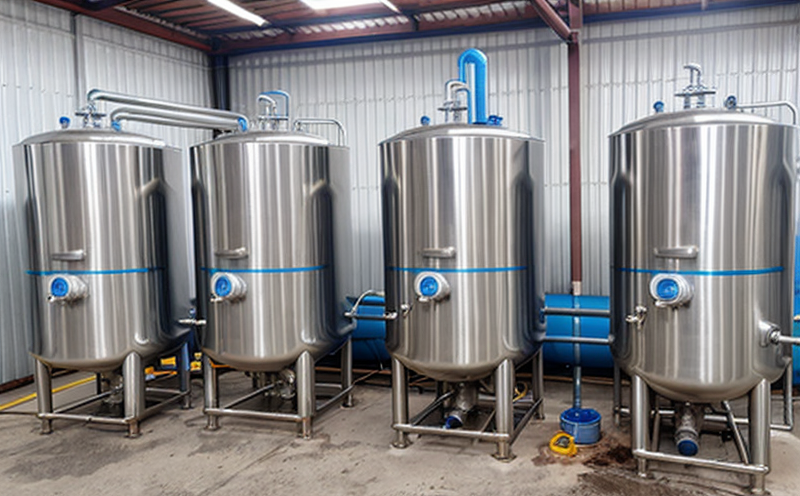ASTM D2330 pH Electrometric Test in Boiler Water
The ASTM D2330 standard specifies the procedure for determining the pH of boiler water using an electrometric method. This test is essential for ensuring optimal performance and longevity of boilers, preventing corrosion, scaling, and other harmful effects on equipment and efficiency. The primary goal is to maintain a balanced pH within the boiler system to prevent the formation of scale or corrosion products that can lead to premature failure.
The pH of boiler water plays a critical role in various aspects of boiler operation:
- Prevention of acidic and alkaline corrosion
- Maintaining solubility of salts and other dissolved substances
- Optimizing the effectiveness of corrosion inhibitors and scale preventatives
- Safeguarding against thermal shock by managing temperature variations in the system
The electrometric method involves measuring the potential difference between two electrodes immersed in the boiler water. This process requires precise calibration and accurate instrumentation to ensure reliable results. The test is typically conducted at specific intervals or when routine maintenance checks indicate a need for adjustment.
| Test Parameter | Description |
|---|---|
| pH Range | The specified range for boiler water pH according to ASTM D2330 is 9.5–10.5, ensuring optimal conditions that prevent scale formation and corrosion. |
| Temperature Control | Maintaining the correct temperature during measurement ensures accurate readings due to the influence of temperature on pH. |
| Sample Preparation | The sample should be taken from a point where it is representative of the boiler water, ensuring consistency with the test parameters. |
| Instrument Calibration | Calibration must be performed using standard solutions and verified against known pH values before each test. |
The calibration process involves using a buffer solution to adjust the electrodes to known pH levels. This ensures that any variations in the reading can be attributed to changes in boiler water composition rather than instrument accuracy.
Once calibrated, the electrodes are immersed in the sample and allowed to reach equilibrium. The potential difference between the two electrodes is measured, providing a precise pH value for the boiler water. This value is then recorded along with any other relevant data points such as temperature and conductivity, which can influence the results.
The results of this test are crucial for quality managers and compliance officers in ensuring that the boiler system operates within safe parameters. For R&D engineers, it provides insights into how different additives or water treatment methods affect pH levels and overall performance. Procurement personnel benefit from accurate pH readings to ensure they source chemicals and treatments that meet industry standards.
Why It Matters
The importance of maintaining the correct pH in boiler water cannot be overstated. A well-maintained pH level ensures optimal performance, extends equipment lifespan, and minimizes operational costs associated with repairs and replacements. Deviations from the specified range can lead to significant issues:
- Corrosion: An acidic environment can cause metal components to corrode rapidly.
- Scaling: High alkaline levels promote scale formation, which reduces heat transfer efficiency.
- Ineffective Corrosion Inhibitors: Incorrect pH can render protective treatments ineffective, leading to increased maintenance needs.
- Economic Losses: Premature equipment failure and increased energy consumption contribute to higher operational costs.
Regular testing and adherence to ASTM D2330 guidelines help operators identify potential issues early, allowing for timely interventions. This proactive approach not only enhances safety but also optimizes resource utilization and extends the life cycle of critical assets.
Industry Applications
- Power Generation: Ensuring optimal boiler water pH is crucial in large-scale power plants to maintain efficiency and prevent costly downtime.
- Industrial Manufacturing: Many manufacturing processes rely on boilers for steam generation, making accurate pH control vital for consistent product quality.
- Oil & Gas: In refining and extraction operations, precise boiler water management prevents scaling issues that can disrupt critical processes.
- Agricultural Processing: Boiler systems in food processing plants require stringent pH control to meet hygiene standards and prevent contamination.
The consistent application of ASTM D2330 ensures reliability across these diverse sectors. By adhering to this standard, organizations not only comply with regulatory requirements but also safeguard their investments and operations.
Use Cases and Application Examples
| Use Case | Description |
|---|---|
| New Boiler Installation | Testing the initial boiler water to ensure it meets the specified pH range before commissioning. |
| Periodic Maintenance Checks | Conducting regular tests to monitor changes in pH and identify potential scaling or corrosion issues early. |
| Additive Testing | Evaluating the effectiveness of new water treatment chemicals by measuring their impact on boiler water pH. |
| Demand Response Programs | Adjusting boiler settings based on real-time pH data to optimize energy consumption and operational efficiency. |
These use cases highlight the versatility of ASTM D2330 in various industrial contexts. By integrating this test into routine maintenance protocols, organizations can proactively manage their boiler systems, leading to enhanced performance and reduced downtime.





